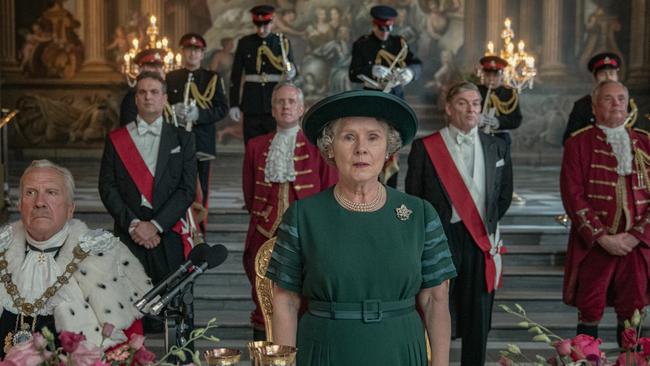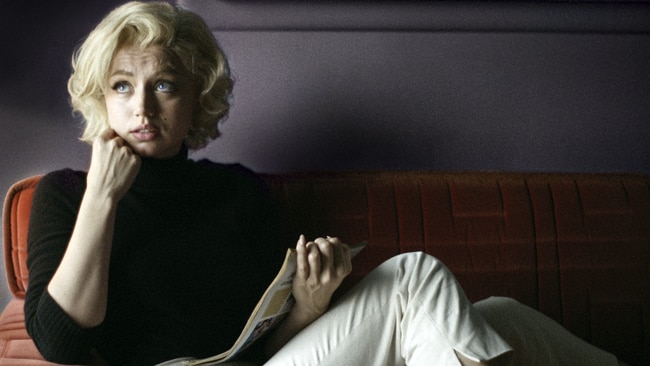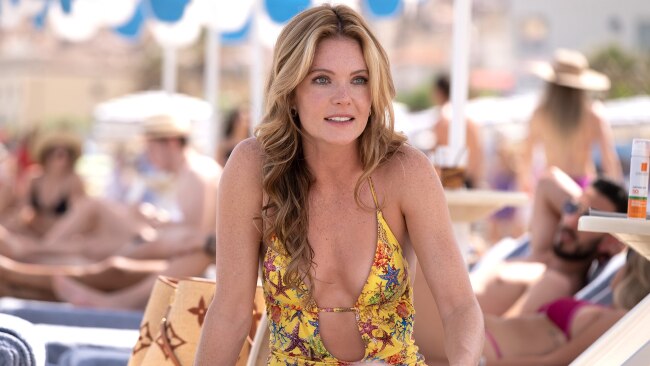Where do we draw the line on dramatic licence?
As The Crown returns to our screens with the usual furore over its historical accuracy it must be asked, why would you make it up when you don't have to?

You can make it all up. But why would you?
This is an opinion article.
One of Britain’s favourite sports resumes next week: the annual shooting of holes in the latest series of The Crown. Although open season on its inaccuracies, inventions and absurdities must fairly wait until November 9, when the new episodes are screened, Judi Dench emptied the first few barrels a fortnight ago when she wrote to The Times to say series five looked “cruelly unjust” on the Windsors. Jonathan Pryce, who now plays Prince Philip, confessed himself “hugely disappointed” by this attack from his “fellow artiste”, but Netflix - perhaps observant of its focus groups’ heightened affection for the show’s posthumous lead character - now bills The Crown as “a fictional dramatisation”. So that’s all right.
Peter Morgan, to whose creative genius I of course doff my shooting cap, has been whipping recent history into drama since The Deal (about Tony Blair and Gordon Brown) in 2003. He will not be too worried by the extra publicity. As the show has cantered ever further from the narrow path of historical truth, I cannot be alone in coming to regard its spot-the-fib challenges as part of the fun.
Yet there are surely only so many holes a serious drama based on living history can take before it begins to resemble, whatever the size of its budget, a tattered shroud flung over the truth. I know two women who separately switched off Blonde, Andrew Dominik’s new biopic of Marilyn Monroe, at the moment when she went home for a threesome with the sons of Charlie Chaplin and Edward G Robinson. There is no evidence for this happening at all - and my wife and my commissioning editor both intuited this without troubling Google.

A similar instinct steered the former Telegraph editor Charles Moore and me away from the 2017 Churchill movie Darkest Hour. What put us off was the scene in which Winston wobbled aboard an Underground train bound for Westminster. There is only one report of Churchill travelling by Tube and it didn’t happen in 1940. Nor is there any evidence that friendly proles (had there been any) fortified the prime minister’s determination not to settle with Hitler, still less that they inspired his “never surrender” speech. I have still not seen the whole film, but the scene looks just as I feared: phoney as hell.
Let us not be unforgiving pedants. We all make mistakes. What, after all, do a wristwatch in Ben-Hur, a TV aerial in Downton, a speedboat emblazoned with a website address on ITV’s Sixties-set The Ipcress File offer but momentary delights? James Graham, who is Morgan’s equal as a dramatist and superior as a historian, included in This House, his 2012 play about the 1974-79 Labour governments, a joke about the Tories having no Scottish MPs. That was almost true when he wrote the play, but in October 1974 Scotland elected 16 Conservatives. Even Shakespeare nods. In Julius Caesar he has Cassius say “the clock hath stricken three”, many centuries before the invention of clockwork (perhaps it was a postmodern joke).
We should also be realistic about budgets. The past, wrote LP Hartley in his novel The Go-Between, is a foreign country. Film producers know he was right: it costs a fortune to get there. So what if there was the wrong Routemaster on Foyle’s War? Must every TV show build an exact replica of a period bus to appease transport anoraks? And in some cases an apparently slapdash shortcut functions perfectly well in establishing a mise en scene. In 1957 the French semiotician Roland Barthes wrote an essay on the importance as “signifiers” of the fringe haircuts sported by every single Roman in Joseph L Mankiewicz’s film Julius Caesar. The same justification can be made for Meryl Streep wearing a hat in the Commons while playing Mrs Thatcher in The Iron Lady. Maggie never did, but that hat signified Thatcherliness.

Egregious overegging should attract not scorn but pity. Dumbing down is a terrible thing; it can poison the creative mind. A drama series on Leonardo da Vinci starring Aidan Turner could have been great, but someone lost their nerve and demanded a plot in which the artist was arrested for killing his model for the Mona Lisa. Could Leonardo have worked without a murder, I asked Turner this summer. “Of course it could,” he replied.
The ethical problems occur only when an apparently serious piece of work cheats to make its case.
The catch-all excuse that it is justifiable to lie in order to tell a wider/deeper/more important truth seems to be the prerogative of artists with a political agenda alone.
Morgan is not such an artist, but the playwright Alan Bleasdale was certainly accused of being one in the row over his 1986 BBC drama The Monocled Mutineer. It was about Percy Toplis, the supposed leader of an army mutiny at Etaples camp in France during the First World War. The show, broadcast at a time when a Conservative government was spatting with the BBC over its “unpatriotic” coverage of the Falklands conflict and Northern Ireland, was seen as a bash at the officer class and a dishonouring of dead heroes depicted on the rampage through northern France.
The factual problem was that Toplis was not at Etaples. He was, however, a conman, a rapist and later a murderer. Also, according to historians, the Etaples rampage wasn’t that much of a riot; there was no rape and pillage. The BBC’s managing director Bill Cotton defended the series as “a play about the greater truth of the First World War” and if that greater truth was that brutalised people can behave brutally, he had a point. Nevertheless, within a few weeks Alasdair Milne was deposed as the BBC’s director-general. In television, dangerous writing costs jobs.
It is worse, however, when art destroys reputations not out of ideological fervour but on a hunch, a whim, the sniff of a good story. Richard III’s reputation has never, of course, recovered from Shakespeare’s history play, but the great modern example of a drama speaking ill of the dead is Peter Shaffer’s play and 1984 film Amadeus, in which the composer Antonio Salieri is shown so enflamed by jealousy of the young Mozart that he poisons him. In fact the two appear to have been friends and collaborators. Mozart probably died of strep throat. And yet - would we really want to be without either The Tragedy of King Richard III or Amadeus?
The point, of course, is that both the king and the composer are long dead. The dead don’t care, and in these cases their families and friends were dead too. The latter is not true, however, of the former Labour leader Michael Foot, who in Abi Morgan’s The Iron Lady was shown protesting against Thatcher’s decision to send the task force to the Falkland Islands. Far from demolishing Foot from the dispatch box, she was grateful for his support.
Nor were the friends of the cellist Jacqueline du Pre, who died young of multiple sclerosis, beyond caring when the 1998 film Hilary and Jackie began winning prizes. In the movie, based on a book by du Pre’s sister, Hilary, and her brother, Piers, the musician came over as unstable, vicious and manipulative, while Hilary was shown selflessly agreeing that she might sleep with her husband. A distinguished group of musicians wrote to The Times that this was not “the Jacqueline du Pre that we, as her friends and colleagues, knew”.
At least when the film came out du Pre herself had been dead for more than a decade. Imagine being Rachel DeLoache Williams, the junior New York journalist massively conned and defrauded by the fake Russian heiress Anna Sorokin. This year Williams watched Inventing Anna, Netflix’s serial about the con artist, only to see a version of herself as scrounging social climber. “Netflix,” she told me, “cherry-picked pieces of truth to create a narrative that is not true.” And how did it get away with this? With the larky disclaimer: “This whole story is completely true. Except for all the parts that are totally made up.”

So what about this “fictional dramatisation/based on a true story” caption we are now so used to? What seems to me like a commonsense interpretation of its scope was made back in 2008. BBC Four had broadcast an entertaining and well-acted film called The Curse of Steptoe about the relationship between the two leads of the Sixties sitcom Steptoe and Son, Wilfrid Brambell and Harry H Corbett. Brian Fillis’s screenplay played crazy with chronology and Corbett’s private life but its essential offence was to depict the two stars as loathing each other. Ray Galton and Alan Simpson, who wrote the hit comedy, swore it wasn’t true, not even a little bit.
After complaints by Corbett’s brother-in-law, the BBC Trust demanded changes and the first repeat was prefaced with: “The following drama is inspired by the lives of real people. For the purpose of the narrative some events have been invented or conflated.” But the changes were not sufficient for Corbett’s brother-in-law, who complained anew. The Curse of Steptoe was eventually never shown again and the trust declared in exasperation: “The use of captions such as this should not be regarded as a ‘blank cheque’ for the indiscriminate and excessive use of dramatic licence.”
Audiences are sophisticated. We know a feature film is not life, a TV screen not a window. We understand that dialogue is not conversation, that a story sometimes has too many characters and too many events and so some may be conflated. We get it that a narrative is different from a timeline. If a drama takes too many liberties, however, we simply stop believing it, and if it all seems to have been done in bad faith towards living or until recently living people - well, then we feel that is wrong.
Take that scion threesome in Blonde. The offence is not only that it never happened. People are angry with Dominik because the writer-director wanted it to have happened. In a brilliant Be Kind Rewind video essay on the film, a critic who calls herself simply Izzy notes that this was a movie of “unyielding horror”. The problem, she goes on, is not that the story was fictionalised but that it became “a near gleeful takedown of a woman who is surely [in the director’s mind] to blame for her misfortune”. Dominik saw Monroe not as a skilled and spirited actress but as an “avatar for suffering” and nothing else. He rewrote her life to prove himself right.
I shall add one thing, though. Given how much true crime drama there is on British television right now, it is remarkable how few complaints there are from friends and relatives of the victims about accuracy (about bad taste is another matter - both Netflix’s Monster: The Jeffrey Dahmer Story and Channel 5’s Maxine Carr Soham murders drama have been called that). Some creatives at least show the dead the respect by not embellishing their tragedies.
Peter Morgan, as we know, can choose another path, but perhaps one day a majority of dramatists will come round to a view long shared by good journalists that while the truth is not always stranger than fiction, its nuances make it more interesting. You could make it up, but why would you?


